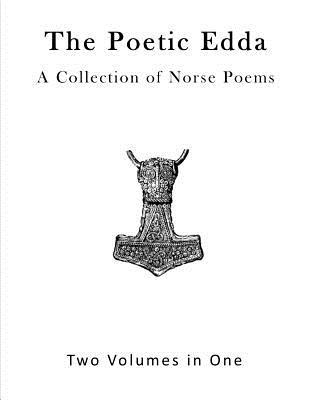The Poetic Edda
A Collection of Norse Poems
Translated from the Icelandic with an Introduction and Notes
By Henry Adams Bellows
Two Volumes in One
American Scandinavian Foundation
The Poetic Edda is the modern attribution for an unnamed collection of Old Norse poems. Several versions exist, all consisting primarily of text from the Icelandic mediaeval manuscript known as the Codex Regius. The Codex Regius is arguably the most important extant source on Norse mythology and Germanic heroic legends, and from the early 19th century onwards has had a powerful influence on later Scandinavian literatures, not merely through the stories which it contains, but also through the visionary force and dramatic quality of many of the poems. It has also become an inspiring model for many later innovations in poetic meter, particularly in the Nordic languages, offering many varied examples of terse, stress-based metrical schemes working without any final rhyme, and instead using alliterative devices and strongly concentrated imagery. Poets who have acknowledged their debt to the Poetic Edda include Vilhelm Ekelund, August Strindberg, J.R.R. Tolkien, Ezra Pound, Jorge Luis Borges, and Karin Boye.
THERE is scarcely any literary work of great importance which has been less readily available for the general reader, or even for the serious student of literature, than the Poetic Edda. Translations have been far from numerous, and only in Germany has the complete work of translation been done in the full light of recent scholarship. In English the only versions were long the conspicuously inadequate one made by Thorpe, and published about half a century ago, and the unsatisfactory prose translations in Vigfusson and Powell's Corpus Poeticum Boreale, reprinted in the Norroena collection. An excellent translation of the poems dealing with the gods, in verse and with critical and explanatory notes, made by Olive Bray, was, however, published by the Viking Club of London in 1908. In French there exist only partial translations, chief among them being those made by Bergmann many years ago. Among the seven or eight German versions, those by the Brothers Grimm and by Karl Simrock, which had considerable historical importance because of their influence on nineteenth century German literature and art, and particularly on the work of Richard Wagner, have been largely superseded by Hugo Gering's admirable translation, published in 1892, and by the recent two volume rendering by Genzmer, with excellent notes by Andreas Heusler, 194-1920. There are competent translations in both Norwegian and Swedish. The lack of any complete and adequately annotated English rendering in metrical form, based on a critical text, and profiting by the cumulative labors of such scholars as Mogk, Vigfusson, Finnur Jonsson, Grundtvig, Bugge, Gislason, Hildebrand, Luning, Sweet, Niedner, Ettmuller, Mullenhoff, Edzardi, B. M. Olsen, Sievers, Sijmons, Detter, Heinzel, Falk, Neckel, Heusler, and Gering, has kept this extraordinary work practically out of the reach of those who have had neither time nor inclination to master the intricacies of the original Old Norse.
CONTENTS INCLUDE:
General Introduction
Lays of the Gods
Voluspo
Hovamol
Vafthruthnismol
Grimnismol
Skirnismol
Harbarthsljoth
Hymiskvitha
Lokasenna
Thrymskvitha
Alvissmol
Baldrs Draumar
Rigsthula
Hyndluljoth
Svipdagsmol
Lays of the Heroes
Plus many more......
